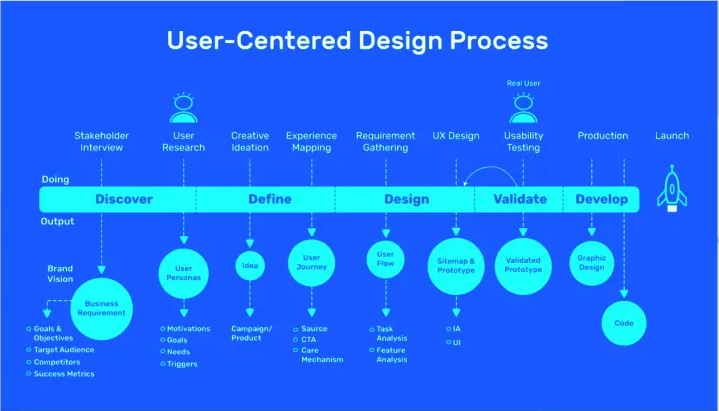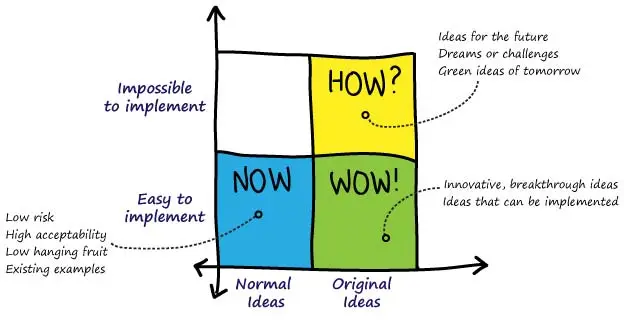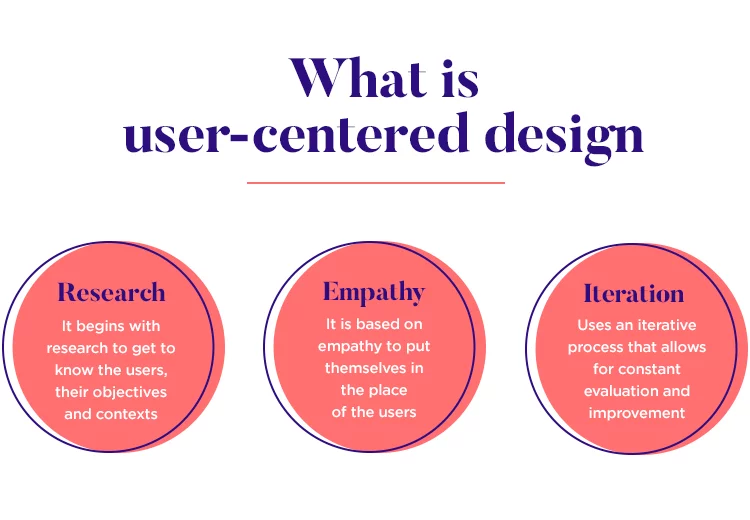Introduction to User-Centered Design (UCD)
User-Centered Design (UCD) is a framework that prioritizes the needs, preferences, and limitations of end-users at every stage of the design process.
Rooted in empathy and iterative validation, UCD ensures that products and services solve real problems while delivering intuitive experiences. According to the ISO 9241-210 standard, UCD involves “designing solutions that are effective, efficient, and satisfying for the intended users” [1].
In this guide, we’ll dissect the UCD process, phase by phase, and explore tools, methodologies, and real-world applications.
Why User-Centered Design (UCD) Matters in Modern UX
In an era where 88% of users are less likely to return to a website after a poor experience [2], UCD bridges the gap between business goals and user expectations. By aligning stakeholders, validating assumptions, and refining solutions, teams reduce costly redesigns and build loyalty. For example, IBM reported a 300% ROI after adopting UCD practices [3].
Phase 1: Discover – Laying the Foundation
Key Activities:
- Stakeholder Interviews: Align business objectives with user needs. Tools like Miro or Mural facilitate collaborative workshops.
- User Research: Conduct surveys, interviews, and ethnographic studies. Platforms like UserInterviews.com streamline recruitment.
- Competitor Analysis: Audit competitors using frameworks like SWOT or Heuristic Evaluation. Tools: SimilarWeb, Hotjar.
- Success Metrics: Define KPIs (e.g., task completion rate, NPS).
Outputs: Brand vision, business requirements, target audience profiles.
Pro Tip: Use Google’s HEART Framework to quantify user happiness and engagement [4].
Phase 2: Define – Synthesizing Insights
Key Activities:
- User Personas: Create data-driven personas using tools like Xtensio. Avoid assumptions—base personas on research.
- Journey Mapping: Visualize touchpoints and pain points (Smaply or UXPressia).
- Requirements Gathering: Prioritize features with MoSCoW Method (Must-have, Should-have, Could-have, Won’t-have).
Outputs: User journeys, task analyses, feature lists.
Case Study: Airbnb revamped its onboarding flow after mapping user frustrations, increasing conversions by 10% [5].
Phase 3: Design – From Concepts to Prototypes
Key Activities:
- Wireframing: Low-fidelity sketches using Balsamiq or Figma. Focus on functionality over aesthetics.
- Prototyping: Interactive models built with InVision or Adobe XD. Test navigation flows early.
- UX Writing: Craft microcopy that guides users (e.g., error messages, CTAs).
Outputs: Wireframes, clickable prototypes, user flows.
Pro Tip: Follow Nielsen’s 10 Usability Heuristics for intuitive layouts [6].
Phase 4: Validate – Testing and Iteration
Key Activities:
- Usability Testing: Conduct moderated sessions via Lookback.io or unmoderated tests via UserTesting.com.
- A/B Testing: Compare design variants using Optimizely or Google Optimize.
- Accessibility Audits: Ensure compliance with WCAG 2.1 using axe DevTools [7].
Outputs: Validated prototypes, refined user flows.
Stat: Fixing issues post-launch can cost 10x more than during design [8].
Phase 5: Develop – Bringing Designs to Life
Key Activities:
- Graphic Design: Use Sketch or Figma for high-fidelity visuals.
- Front-End Development: Collaborate with developers using Storybook for component libraries.
- Launch: Monitor performance with Hotjar (heatmaps) and Google Analytics.
Outputs: Final product, style guides, codebase.
Case Study: Slack’s beta launch included continuous user feedback loops, driving 8 million DAUs within six years [9].
Common Pitfalls and Solutions
- Skipping Research: Solution: Allocate 20% of project time to discovery [10].
- Overloading Features: Solution: Apply the Kano Model to prioritize delights vs. basics.
- Ignoring Accessibility: Solution: Audit early with tools like WAVE.
Future Trends in User-Centered Design (UCD)
- AI-Driven Personalization: Tools like Adobe Sensei predict user behavior.
- Voice UX: Design for platforms like Alexa using Voiceflow.
- Ethical Design: Address dark patterns via resources like EthicalDesign.guide.
Conclusion
The UCD process is not linear but cyclical. By embracing empathy, iteration, and collaboration, teams create solutions that resonate deeply with users.
As Don Norman, the father of UX, said:
“Design is really an act of communication, which means having a deep understanding of the person with whom the designer is communicating.” [11].
References
[1] ISO 9241-210:2019 Ergonomics of Human-System Interaction
[2] Gomez: The Impact of Website Performance on User Behavior
[3] IBM Design Thinking ROI Study
[4] Google HEART Framework
[5] Airbnb Design: Redesigning Trust
[6] Nielsen Norman Group: 10 Usability Heuristics
[7] WebAIM: WCAG 2.1 Checklist
[8] IEEE: Cost of Fixing Errors
[9] Slack: Building a User-Centered Product
[10] NN/g: The 6:1 Ratio for Research
[11] Don Norman: The Design of Everyday Things
Tools Mentioned:
This guide equips you to implement UCD with precision. For further reading, explore Interaction Design Foundation or Nielsen Norman Group’s archives.


